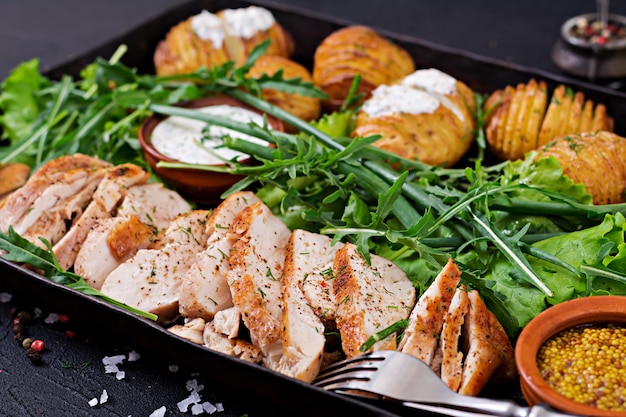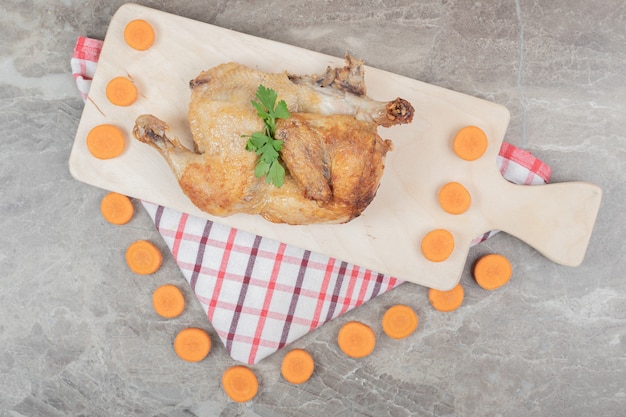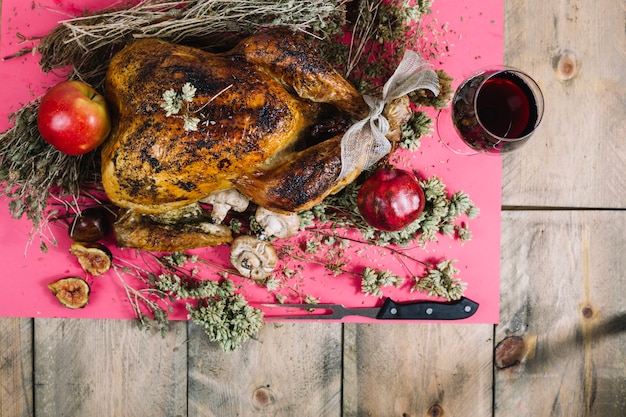(Part 1) Choosing the Right Turkey Breast

What to look for in a bone-in turkey breast:
- Freshness: The turkey should be chilled properly with no signs of discoloration or spoilage. A good way to check is to sniff the meat – it should smell fresh, not sour or off.
- Size: The size of the breast you need depends on the number of people you're serving. A bone-in turkey breast usually serves 4-6 people, so choose one that's big enough without being overwhelming.
- Fat content: You want a nice, even layer of fat. It's like a built-in moisturizer for your turkey breast, keeping it juicy and tender during cooking.
- Color: The skin should be a healthy, slightly golden color.
Where to buy a turkey breast
You can usually find bone-in turkey breasts at your local supermarket or butcher shop. And if you're feeling a bit adventurous, you might even find them already brined. Brining is a process of soaking the turkey in a salty solution, which helps to lock in moisture and flavor, resulting in a juicier, more flavorful bird. If you're feeling ambitious, you could even try brining it yourself!My personal tip for choosing a turkey breast
Don't be afraid to ask for help! The butcher is your friend – they're the experts, so ask them about the freshest birds and what size they recommend for your needs. They can often tell you which turkeys have the best flavor, too.(Part 2) Preparing the Turkey Breast

Thawing the turkey breast
If you've bought a frozen turkey breast, you need to thaw it before you can cook it. The safest way to thaw a turkey is in the refrigerator. This takes time, so plan ahead. A small turkey breast might take a day or two, while a larger one can take several days.Patting the turkey breast dry
Once your turkey is thawed, pat it dry with paper towels. This step is essential for achieving a crispy skin. Think of it as prepping your canvas before you start painting – you want a dry surface for the seasoning to adhere to and for the skin to crisp up beautifully.Seasoning the turkey breast
This is the part where you get to inject your personal flavor into the dish. I like to keep my turkey breast seasoning simple, allowing the natural flavors of the meat to shine.Classic Turkey Breast Seasoning
1 tablespoon olive oil – this helps the seasoning stick to the turkey 1 teaspoon salt – the foundation of any good seasoning 1/2 teaspoon black pepper – a touch of spice 1/2 teaspoon garlic powder – a hint of savory deliciousness 1/4 teaspoon onion powder – for an added layer of depth 1/4 teaspoon dried thyme – a fragrant herb that complements turkey perfectlyMy personal twist
I love to add a little bit of brown sugar to my seasoning mix for a hint of sweetness. It adds a caramel-like note to the skin as it crisps up, and it just elevates the flavor profile.Rubbing in the seasoning
Now, rub that seasoning mixture all over the turkey breast, making sure to get into every nook and cranny. You want to coat the meat thoroughly, so don't be shy with the seasoning.Optional: Adding a butter and herb mixture
For an extra touch of flavor and moisture, you can rub a mixture of butter and herbs under the skin of the turkey breast. This is a bit of a culinary trick that adds a delicious layer of richness to the meat. I like to use a combination of herbs like rosemary, sage, and thyme.(Part 3) Roasting the Turkey Breast

Choosing the right roasting pan
You need a roasting pan that's big enough to accommodate your turkey breast comfortably. It should have a rack that elevates the bird so it doesn't sit in its own juices. This allows air to circulate around the turkey, helping it to cook evenly.Preheating the oven
Preheat your oven to 350 degrees fahrenheit (175 degrees Celsius). This ensures the turkey breast cooks evenly and prevents it from becoming dry.Placing the turkey breast in the oven
Carefully place the turkey breast in the roasting pan, breast side up. I like to add a few cups of water to the bottom of the pan. This creates steam that helps to keep the turkey breast moist.Cooking time
Cooking time depends on the size of the turkey breast. A good rule of thumb is to allow about 20-25 minutes per pound. For example, a 5-pound turkey breast will take about 100-125 minutes to cook.Using a meat thermometer
Don't rely solely on the cooking time – use a meat thermometer to ensure the turkey breast is cooked through. It's done when the internal temperature reaches 165 degrees Fahrenheit (74 degrees Celsius).Resting the turkey breast
Once the turkey is cooked, take it out of the oven and let it rest for 10-15 minutes before carving. This allows the juices to redistribute, resulting in a tender, flavorful turkey breast.(Part 4) Grilling the Turkey Breast
For a smoky, flavorful experience, grilling is a great way to cook your turkey breast. It's a little more hands-on than roasting, but the effort is definitely worth it.Preheating the grill
Preheat your grill to medium heat. If you're using charcoal, make sure the coals are evenly distributed and covered with a layer of ash.Preparing the grill
Clean the grill grate with a wire brush and lightly oil it to prevent sticking.Placing the turkey breast on the grill
Carefully place the turkey breast on the grill, breast side up. Close the lid and cook for about 15 minutes per side, or until the turkey breast reaches an internal temperature of 165 degrees Fahrenheit (74 degrees Celsius).Using a meat thermometer
Use a meat thermometer to check the internal temperature.Resting the turkey breast
Once the turkey is cooked, remove it from the grill and let it rest for 10-15 minutes before carving.(Part 5) Smoking the Turkey Breast
For a truly unique flavor profile, consider smoking your turkey breast. It's a longer process, but the result is a deliciously tender and smoky bird.Choosing the right smoker
You'll need a smoker that can maintain a steady temperature between 225 and 250 degrees Fahrenheit (107 and 121 degrees Celsius).Preparing the smoker
Fill the smoker with your preferred wood chips and heat it to the desired temperature. Experiment with different wood chips to find the flavor you like best. I love the combination of hickory and applewood for a sweet, smoky taste.Placing the turkey breast in the smoker
Carefully place the turkey breast in the smoker, breast side up. Close the lid and cook for about 4-5 hours, or until the turkey breast reaches an internal temperature of 165 degrees Fahrenheit (74 degrees Celsius).Using a meat thermometer
Use a meat thermometer to check the internal temperature.Resting the turkey breast
Once the turkey breast is cooked, remove it from the smoker and let it rest for 10-15 minutes before carving.(Part 6) Carving the Turkey Breast
You've put in the time and effort, and now it's time to reap the rewards!Allowing the turkey breast to rest
Remember to let the turkey breast rest for at least 10-15 minutes before carving. This allows the juices to redistribute, ensuring a tender, flavorful turkey breast.Using a sharp carving knife
A sharp carving knife is essential for clean, precise cuts. This prevents tearing the meat and ensures you get beautifully sliced turkey.Carving the turkey breast
Start by carving the turkey breast into thin slices, following the grain of the meat. You can then slice the breast into individual servings or leave it as a whole roast.Serving the turkey breast
Serve the carved turkey breast warm with your favorite sides. I love to serve it with mashed potatoes, gravy, and cranberry sauce. But feel free to get creative!(Part 7) Troubleshooting Turkey Breast Cooking
Even the most experienced cooks encounter glitches in the kitchen. Here are a few common turkey breast cooking problems and how to fix them:Dry turkey breast
A dry turkey breast is a common problem, especially with larger birds. To prevent it, use a meat thermometer to ensure it's cooked to the right temperature and don't overcook it. You can also try basting the turkey with pan juices or butter to keep it moist during cooking.Undercooked turkey breast
It's crucial to cook your turkey breast thoroughly to prevent foodborne illness. Use a meat thermometer to ensure it reaches an internal temperature of 165 degrees Fahrenheit (74 degrees Celsius) before serving. If you're unsure, it's better to err on the side of caution and cook it a little longer.Burnt turkey breast
If the skin is browning too quickly, reduce the oven temperature or tent the turkey breast with foil.(Part 8) Serving Suggestions
You've cooked the perfect turkey breast, now it's time to present it beautifully.Classic sides for turkey breast
Here are some classic sides that pair well with turkey breast: Mashed potatoes – a creamy, comforting side Gravy – a rich and flavorful sauce that enhances the taste of turkey Cranberry sauce – a sweet and tart counterpoint to the savory turkey stuffing – a savory mixture of bread, herbs, and vegetables that complements the turkey perfectly green bean casserole – a classic Thanksgiving side dish sweet potato casserole – a sweet and savory side that's perfect for a special occasionMy personal favorites
I love to serve my turkey breast with a simple salad and a side of roasted vegetables. The crispness of the salad and the sweetness of the roasted vegetables provide a nice contrast to the richness of the turkey.Making the most of leftovers
Don't let those delicious leftovers go to waste! You can use them to make turkey sandwiches, turkey soup, or even turkey salad.(Part 9) Storage and Reheating
You've cooked and served your turkey breast, but what about those leftovers? Here's how to store and reheat them properly.Storing turkey breast
Let the cooked turkey breast cool completely before storing in an airtight container. It's safe to store in the refrigerator for 3-4 days.Reheating turkey breast
You can reheat turkey breast in the oven, microwave, or on the stovetop. Just make sure it's heated through before serving.FAQs
How long can you store cooked turkey breast in the refrigerator?
You can store cooked turkey breast in the refrigerator for 3-4 days.What is the best way to reheat turkey breast?
You can reheat turkey breast in the oven, microwave, or on the stovetop. Just make sure it's heated through before serving.How do you know if turkey breast is cooked through?
Use a meat thermometer to check the internal temperature of the turkey breast. It's done when it reaches 165 degrees Fahrenheit (74 degrees Celsius).What are some good side dishes for turkey breast?
Classic sides for turkey breast include mashed potatoes, gravy, cranberry sauce, stuffing, green bean casserole, and sweet potato casserole.Can you freeze cooked turkey breast?
Yes, you can freeze cooked turkey breast for up to 2-3 months. Just make sure to wrap it tightly in freezer-safe plastic wrap or aluminum foil. I hope this guide has given you the confidence to cook a bone-in turkey breast that's both delicious and impressive. Remember, practice makes perfect, so don't be afraid to experiment and find what works best for you. Happy cooking!Everyone is watching

Corn on the Cob: The Ultimate Guide to Perfectly Cooked Ears
Healthy MealsAh, corn on the cob. Just the name evokes images of sunny days, barbecues, and that sweet, juicy flavour that ...

Scallops: The Ultimate Guide to Perfect Cooking
Healthy MealsAh, scallops. Those delicate, sweet, and utterly delicious morsels of the sea. They hold a special place in my...

Spaghetti Squash: The Ultimate Guide to Cooking and Serving
Healthy MealsRemember that time you saw spaghetti squash at the supermarket, looking all bumpy and strange, and thought, "W...

Salmon Cooking Times: Perfect Guide for Every Recipe
Healthy MealsLet me tell you, cooking salmon is an art form. It's all about getting that perfect balance: juicy and tender,...

Ham Cooking Time: How Long to Bake, Smoke, or Boil a Delicious Ham
Healthy MealsAh, ham. It's a classic, isn't it? A real crowd-pleaser, especially around holidays. And when done right, it'...
